

Pacific ocean plate tectonic evolution. The Pacific Ocean is the world's largest ocean, covering nearly one-half of the globe.
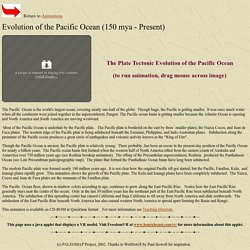
Though huge, the Pacific is getting smaller. It was once much wider when all the continents were joined together in the supercontinent, Pangea. The Pacific ocean basin is getting smaller because the Atlantic Ocean is opening and North America and South America are moving westward. Most of the Pacific Ocean is underlain by the Pacific plate. The Pacific plate is bordered on the east by three smaller plates, the Nazca Cocos, and Juan de Fuca plates. Breakup of gondwana. Blooms Taxonomy Tutorial FLASH - CCCS Faculty Wiki. Forces on a Current-Carrying Wire. CELLS alive! Gallery. Diploid Cell (2N): From a preceding mitotic division, the Oogonium (Spermatogonium) enters meiosis with DIPLOID (2N) chromosomes but TETRAPLOID (4N) DNA.

Chromosomes then duplicate to produce SISTER CHROMATIDS (or HOMOLOGOUS DYADS). Prophase I: Dyad pairs align to create "TETRADS", non-sister chromatids connect and trade sections at a "CHIASMA", a process called "CROSSING OVER". Metaphase I: SPINDLE FIBERS attach to each dyad at the KINETOCHORE. Mitosis: An Interactive Animation. This animation demonstrates the stages of mitosis in an animal cell.
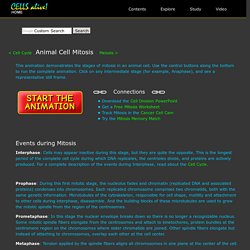
Use the control buttons along the bottom to run the complete animation. Click on any intermediate stage (for example, Anaphase), and see a representative still frame. Interphase: Cells may appear inactive during this stage, but they are quite the opposite. This is the longest period of the complete cell cycle during which DNA replicates, the centrioles divide, and proteins are actively produced. Physics of Superheroes 2 - Electro & Magneto. Physics Flash Animations. We have been increasingly using Flash animations for illustrating Physics content.
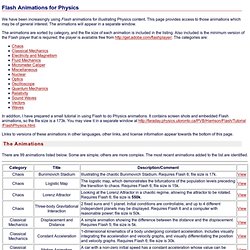
This page provides access to those animations which may be of general interest. The animations will appear in a separate window. The animations are sorted by category, and the file size of each animation is included in the listing. Charging an Electrophorus by Induction Using a Negatively Charge. Inducing a Positive Charge on a Sphere. Charging a Two-Sphere System by Induction Using a Negative Objec.
Multimedia Physics Studios - Table of Contents. Ripple tank circular wave reflection. Ripple tank: circular wave reflection Added by David Fairhurst on Feb 6, 2008 An interactive animation demonstrating circular wave reflection in a ripple tank.
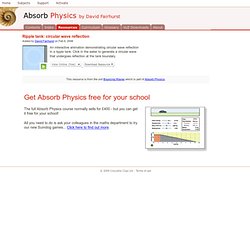
Click in the water to generate a circular wave that undergoes reflection at the tank boundary. This resource is from the unit Bouncing Waves which is part of Absorb Physics. The full Absorb Physics course normally sells for £400 - but you can get it free for your school! All you need to do is ask your colleagues in the maths department to try our new Sumdog games...
Momentum Main Page. The electromagnetic spectrum. IR camera. IR camera Added by David Fairhurst on Feb 6, 2008 An interactive animation showing a night-time view of a town.

Click on the animation to view the scene using an infra-red camera. Ask pupils to identify what they can see. For example, "What can you see in the foreground of the image, just to the right of the centre? ". This resource is from the unit Everyday EM Waves which is part of Absorb Physics. The full Absorb Physics course normally sells for £400 - but you can get it free for your school! All you need to do is ask your colleagues in the maths department to try our new Sumdog games... Real waves on water. Real waves on water Added by David Fairhurst on Feb 6, 2008 An interactive animation illustrating how real water waves propagate.

The motion of water molecules on the surface of the water is highlighted to demonstrate that they move in circles. Diverging lens. Diverging lens Added by David Fairhurst on Feb 6, 2008 An interactive animation demonstrating the virtual image of a pencil produced by a diverging lens.
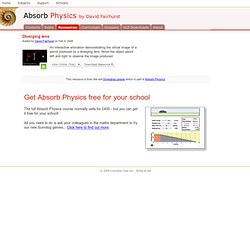
Move the object pencil left and right to observe the image produced. Converging lens. Converging lens Added by David Fairhurst on Feb 6, 2008 An interactive animation demonstrating the real and virtual images of a pencil produced by a converging lens.

Move the object pencil left and right to observe the image produced. This resource is from the unit Converging Lenses which is part of Absorb Physics. The full Absorb Physics course normally sells for £400 - but you can get it free for your school! Combining waves 2 destructive interference. Combining waves 2: destructive interference Added by David Fairhurst on Feb 6, 2008 An interactive animation demonstrating destructive interference.

Three strings of beads are shown: one travelling right to left; the second travelling left to right and the third is the superposition of the first two. Use the slider to propagate a wave or use the step button to slow down the animation. This resource is from the unit Interference which is part of Absorb Physics. Combining waves 1 constructive interference. Combining waves 1: constructive interference Added by David Fairhurst on Feb 6, 2008 An interactive animation demonstrating constructive interference.
Three strings of beads are shown: one travelling right to left; the second travelling left to right and the third is the superposition of the first two. Use the slider to propagate a wave or use the step button to slow down the animation. A wave squeezing a spring. A wave: squeezing a spring Added by David Fairhurst on Feb 6, 2008 An interactive animation illustrating a longitudinal wave. Click the arrow button to play the animation. Investigating weight and upthrust. Investigating weight and upthrust Added by David Fairhurst on Feb 6, 2008 An interactive animation illustrating upthrust with a rock and an apple.
Click the arrow button to lower an object into the water and raise it again. A spring balance displays the apparent weight of the object in and out of the water. Click the arrow button to change the object. Balancing a seesaw. Balancing a seesaw Added by David Fairhurst on Feb 6, 2008 An interactive animation demonstrates a seesaw. Two weights on the seesaw and moved backwards and forward and their weight adjusted to balance or unbalance the seesaw. A ball moving in a circle. The cell an electron pump. Spraying a car. Oersted's experiment. Oersted's experiment. Generating electricity. Magnetic field solenoid. A moving magnet in a coil. A moving wire in a magnetic field measuring the induced current. A gold-leaf electroscope. Rutherford's experiment. Home of CELLS alive!
Science Revision - Games and Activities.